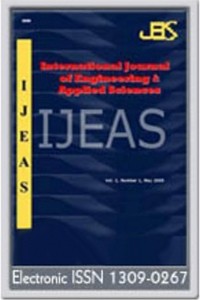The Effect of Member Grouping on the Optimum Design of Grillages with Particle Swarm Method
Grillage optimization, discrete optimum design member grouping, stochastic search technique, particle swarm algorithm,
___
- [1] Bonabeau, E., Dorigo, M. and Theraulaz, G., Swarm Intelligence: From Natural to Artificial Systems, Oxford University Press, U.K., 1999
- [2] Kennedy, J., Eberhart, R.C. and Shi, Y. Swarm Intelligence, Morgan Kaufmann Publishers, 2001
- [3] Kennedy, J. and Eberhart, R.C., Particle Swarm Optimization, In: Proceedings of IEEE International Conference on Neural Networks NJ: Piscataway; 1942-48, 1995.
- [4] Fourie, P. and Groenwold, A. the Particle Swarm Optimization Algorithm in Size and Shape Optimization, Structural and Multidisciplinary Optimization, 23 (4), 259-267, 2002.
- [5] Li, L., Huang, Z. and Liu, F., An Improved Particle Swarm Optimizer for Truss Structure Optimization, Lecture notes in computer science, Berlin/Heidelberg: Springer, 4456, 1-10, 2007.
- [6] He, S., Prempain, E. and Wu, Q.H., An Improved Particle Swarm Optimizer for Mechanical Design Optimization Problems, Engineering Optimization, 36, 5, 585-605, 2004.
- [7] Kaveh, A. and Talatahari, S., A particle swarm ant colony optimization for truss structures with discrete variables, Journal of Constructional Steel Research, 65, 1558- 1568, 2009
- [8] LRFD-AISC, Manual of Steel Construction, Load and Resistance Factor Design, Metric Conversion of the Second Edition, AISC, I & II, 1999
- [9] Venter, G. and Sobieszczanski-Sobieski, J. Multidisciplinary Optimization of a Transport Aircraft Wing Using Particle Swarm Optimization, Structural and Multidisciplinary Optimization, 26, 21-131, 2004.
- [10] Fourie, P. and Groenwold, A., The Particle Swarm Optimization Algorithm in Size and Shape Optimization, Structural and Multidisciplinary Optimization, 23 (4), 259- 267, 2002.
- [11] Perez, R. E. and Behdinan, K., Particle Swarm Approach for Structural Design Optimization, Computers and Structures, 85 (19-20),1579-1588, 2007.
- [12] Arumugam, M.S., Rao, M.V.C. and Chandramohan, A., A new and Improved Version of Particle Swarm Optimization Algorithm with Global–Local Best Parameters, Knowl Inf. Syst. DOI 10.1007/s10115-007-0109-z.
- [13] Erdal, F., Saka, M.P. and Doğan, E., Optimum Design of cellular beams using harmony search and particle swarm optimizers, Journal of Constructional Steel Research, 67(2), 237-247, 2011.
- Başlangıç: 2009
- Yayıncı: Akdeniz Üniversitesi
A. AL-FARUK, N. AHMED, M.a. HAQUE, S.a. MAHMUD
M. Mashud, Abdullah Al-Bari, Md. G. Kader
R. DANESHFARAZ, S. SADEQFAM, M. MAJEDİ-ASL
